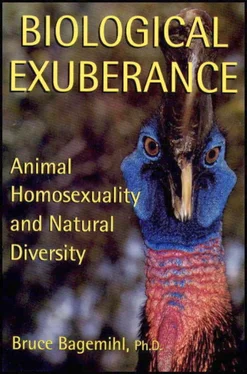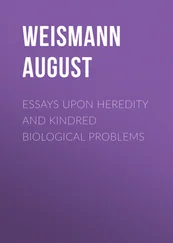How accurate are indigenous views about animal homosexuality and transgender? In other words, do the species associated with homosexuality and transgender in these cultures actually exhibit same-sex behavior or intersexuality? If taken literally, the connection is certainly less than systematic: many animals linked in aboriginal cultures with alternate sexualities are not in fact homosexual, bisexual, or transgendered, while many animals in which sexual and gender variance have been scientifically documented do not have symbolic associations with homosexuality/transgender in these cultures. Moreover, many of the more “fanciful” indigenous beliefs about animals are obviously false (at least in their specifics).
Nevertheless, some striking parallels involving particular species suggest a connection that may be more than fortuitous. For example, homosexuality—including full anal penetration between bulls—is common among American Bison, same-sex courtship and pair-bonding occur in Black-billed Magpies, male and female homosexualities are found in Caribou, and same-sex mounting and coparenting also occur among Bears. These species are all directly identified with homosexuality and/or transgender in some Native American tribes. Moreover, in many cases where the exact species that figures in indigenous conceptions of homosexuality is not accurate, a closely related animal (often in another geographic area) does exhibit the behavior. For example, homosexual activity has not been recorded among New Guinean wallabies, yet it does occur in Australian Wallabies. Likewise, although homosexuality is not yet reported for the cassowary, it has been observed in Emus and Ostriches (related species of flightless birds). Other examples are summarized in the table below.
Some Correspondences Between Indigenous Beliefs and Western Scientific Observations of Animal Homosexuality/Transgender (TG)
| Animal traditionally associated with homosexuality/TG |
Homosexuality/TG reported in scientific literature |
Homosexuality/TG observed in related species |
| NORTH AMERICA |
| Black-tailed Deer (Lakota, Zuni) |
yes (Mule Deer) |
yes (White-tailed Deer) |
| Elk (Oto) |
yes (Wapiti) |
yes (Red Deer, Moose) |
| Buffalo (Lakota, Ponca, Mandan, etc.) |
yes (American Bison) |
yes (other Buffalo species) |
| Bighorn Sheep (Hopi) |
yes (Bighorn Sheep) |
yes (other Mountain Sheep) |
| mountain lion (Okanagon, etc.) |
no |
yes (African/Asiatic Lion) |
| fox, coyote (Arapaho, Okanagon, etc.) |
yes (Red Fox) |
yes (Bush Dog) |
| Gray Wolf, red wolf (Tsistsistas) |
yes (Gray Wolf) |
yes (other Canids) |
| Bears (Nuu-chah-nulth, Keres, etc.) |
yes (Grizzly, Black Bear) |
yes (other carnivores) |
| jackrabbit, cottontail species (Zuni) |
no |
yes (Eastern Cottontail) |
| bat species (Zuni) |
no |
yes (Little Brown Bat, other Bats) |
| golden eagle, Harris’s hawk (Tsistsistas) |
no |
yes (Kestrel, Steller’s Sea Eagle) |
| owl species (Omaha, Mandan) |
yes (Barn Owl) |
yes (Powerful Owl) |
| oriole, tanager species (Tsistsistas) |
no |
yes (Yellow-rumped Cacique) |
| Magpie (Hidatsa) |
yes (Black-billed Magpie) |
yes (other Crows) |
| blue jay (Winnebago) |
no |
yes (Mexican Jay) |
| crow (Kamia) |
no |
yes (Raven, Jackdaw) |
| turtle species (Fox) |
yes (Wood Turtle) |
yes (Desert Tortoise) |
| salmon species (Nuxalk) |
no |
yes (European Salmon species) |
| butterfly/moth species (Navajo) |
yes (Monarch, others) |
yes (other butterfly species) |
| dragonfly species (Tsistsistas) |
yes (Dragonflies) |
yes (Damselflies) |
| NEW GUINEA |
| wild boar, Pig (Bimin-Kuskusmin, Sabarl, etc.) |
yes (domestic Pig) |
yes (Warthog, Peccaries) |
| New Guinean wallabies (Marind-anim) |
no |
yes (Australian Wallabies) |
| arboreal marsupials (Sambia, Bimin-Kuskusmin) |
yes (Tree Kangaroos) |
yes (other marsupials) |
| fruit bat species (Bimin-Kuskusmin) |
no |
yes (other Fruit Bats) |
| echidna (Bimin-Kuskusmin) |
no |
no |
| jabiru stork (Marind-anim) |
no |
yes (White Stork) |
| Raggiana’s Bird of Paradise (Sambia) |
yes (Raggiana’s) |
yes (see below) |
| other birds of paradise (Ai‘i, Sambia, etc.) |
no |
yes (Victoria’s Riflebird) |
| bowerbird species (Sambia, Bimin-Kuskusmin) |
no |
yes (Regent Bowerbird) |
| cassowary (Sambia, Bimin-Kuskusmin, etc.) |
no |
yes (Emu, Ostrich, Rhea) |
| black-capped & purple-bellied lories (Sambia) |
no |
yes (several Lorikeet species) |
| other New Guinean parrots (Sambia) |
no |
yes (Galah) |
| nightjar species (Bimin-Kuskusmin) |
no |
no |
| python species (Bimin-Kuskusmin) |
no |
yes (other snake species) |
| monitor lizard (Bimin-Kuskusmin) |
no |
yes (other lizard species) |
| shark species (Nduindui, Vao) |
no |
no |
| sago grub (Bedamini, Sambia, Bimin-Kuskusmin) |
no |
yes (Southern One-Year Canegrub) |
| centipede species (Bimin-Kuskusmin) |
no |
yes (Spiders, other arthropods) |
| SIBERIA/ARCTIC |
| white whale (Koryak, Inuit) |
yes (Beluga) |
yes (other Whales & Dolphins) |
| bearded, ringed, & Spotted Seals (Yup’ik, Inuit) |
yes (Spotted Seals) |
yes (Harbor Seal, other Seals) |
| Walrus (Chukchi, Yup’ik, Inuit) |
yes (Walrus) |
yes (other pinnipeds) |
| Caribou/Reindeer (Inuit, Yukaghir, Chukchi, etc.) |
yes (Caribou) |
yes (other Deer) |
| Horse (Sakha) |
yes (Takhi, domestic Horse) |
yes (other Equids) |
| Wolf (Sakha) |
yes (Wolf) |
yes (other Canids) |
| Bears (Ob-Ugrian, Nivkh, Chukchi, Inuit, etc.) |
yes (Grizzly, Black, Polar Bears) |
yes (other carnivores) |
| eider duck (Yup’ik) |
no |
yes (Lesser Scaup, other Ducks) |
| loon (Sakha, Yup’ik) |
no |
yes (Grebes) |
| murre species (Yup’ik) |
yes (Common Murre) |
yes (other diving birds) |
| Ruff (Chukchi) |
yes (Ruff) |
yes (other sandpipers) |
| Raven (Sakha, Koryak) |
yes (Raven) |
yes (other Crows) |
| pike species (Sakha) |
no |
yes (Salmon species) |
Some of the most precise correspondences involve transgender (particularly intersexuality) rather than homosexuality per se. Modern science has provided startling confirmation of a number of indigenous “beliefs” about purportedly cross-gendered animals, most notably the left-handed Bear figure of many Native American cultures. Biologists have actually uncovered evidence that some species of Bears probably are left-paw dominant. “Handedness,” or laterality, is a widespread phenomenon in the animal kingdom, with species as diverse as primates, cats, parrots, and even whales and dolphins showing preferences for the use of a right or left appendage (or side of the body) in various behaviors and tasks. 44Although in most species there is considerable variation between individuals as to which side is dominant, it does appear that at least some kinds of Bears are consistently “left-handed.” Scientists and naturalists report that Polar Bears, for example, regularly use their left paw for attack and defense as well as for clubbing seals and hauling them out of the water. In many cases they exhibit greater development of the left paw and may also use their left forelimb and shoulder to carry large objects. The consistency of left-paw use is exemplified by an incident in which wildlife biologists set up snare traps to capture and tag Polar Bears (for long-term study of their migrations). The traps were triggered by the bear’s reaching for some bait with its paw, and all 21 Bears caught in this way were snared by their left front foot. 45Incidentally, there also appears to be a correlation between left-handedness and homosexuality/transgender in humans: a higher than average proportion of gays and lesbians are left-handed (or ambidextrous), and one study found the percentage of left-handers among lesbians to be more than four times that among heterosexual women. Left-handedness also appears to be more common among transsexuals, particularly male-to-female transsexuals. 46As yet, no studies have looked for possible correlations between laterality and homosexuality/transgender in animals.












